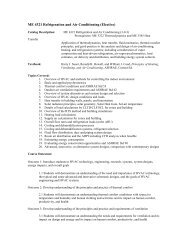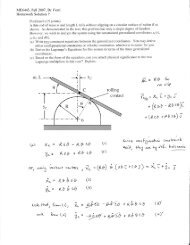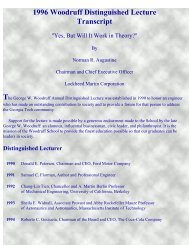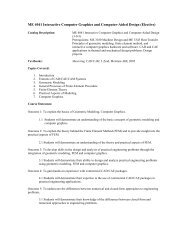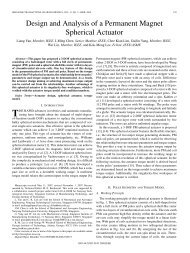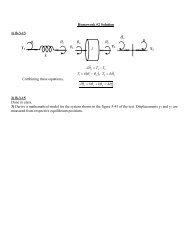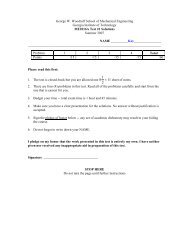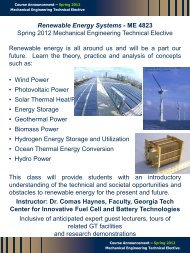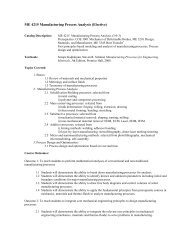Mitigating flow boiling instabilities in microchannels â research needs
Mitigating flow boiling instabilities in microchannels â research needs
Mitigating flow boiling instabilities in microchannels â research needs
You also want an ePaper? Increase the reach of your titles
YUMPU automatically turns print PDFs into web optimized ePapers that Google loves.
NSF/ONR Workshop on Nano/Microscale Thermal Transport,<br />
March 4 th , 2012, GA Tech Global Learn<strong>in</strong>g Center, Atlanta, GA<br />
<strong>Mitigat<strong>in</strong>g</strong> <strong>flow</strong> <strong>boil<strong>in</strong>g</strong> <strong><strong>in</strong>stabilities</strong> <strong>in</strong><br />
<strong>microchannels</strong> — <strong>research</strong> <strong>needs</strong><br />
Yoav Peles<br />
Professor<br />
Rensselaer Polytechnic Institute, Troy, NY
Flow <strong>boil<strong>in</strong>g</strong> <strong><strong>in</strong>stabilities</strong><br />
• Flow <strong>boil<strong>in</strong>g</strong> <strong><strong>in</strong>stabilities</strong> are very notable at<br />
the micro scale<br />
• Flow <strong><strong>in</strong>stabilities</strong><br />
– Reduce the critical heat flux<br />
– Introduce transient surface temperature surges<br />
– Modify the average heat transfer coefficient<br />
– Introduce vibration<br />
– Compromise structural <strong>in</strong>tegrity<br />
• Several <strong>in</strong>stability modes are prevalent <strong>in</strong><br />
<strong>microchannels</strong><br />
Flow
Flow <strong>in</strong>stability modes<br />
• Rapid Bubble Growth<br />
• Led<strong>in</strong>egg (Excursive)<br />
• Parallel channel<br />
• Upstream Compressible Volume<br />
• Critical Heat Flux (CHF)
Rapid bubble growth<br />
Flow<br />
• Mechanism A- liquid superheat<br />
• Mechanism B- bubble dynamics
Mechanism A — Liquid Superheat<br />
Silicon sidewalls<br />
Deep reactive-ion etched structures<br />
exhibit a characteristic scalloped<br />
appearance with average roughness<br />
∼0.3 mm
Mechanism B — bubble dynamics<br />
r<br />
R<br />
Bubble<br />
Hickl<strong>in</strong>g and Plesset (1964)<br />
P ∞<br />
Inf<strong>in</strong>ite liquid<br />
Peak pressure:<br />
p<br />
p<br />
<br />
100R p m<br />
r
Led<strong>in</strong>egg (excursive) <strong>in</strong>stability<br />
G= constant<br />
Dp= constant<br />
T. Harirchian and Dr. S. V. Garimella
Inlet restrictors<br />
DP<br />
Inlet orifice<br />
Inlet orifice<br />
Channel demand curve<br />
Koşar, A., Kuo C.-J., and Peles, Y., “Suppression of <strong>boil<strong>in</strong>g</strong> <strong>flow</strong> oscillations <strong>in</strong> parallel <strong>microchannels</strong> with <strong>in</strong>let<br />
restrictors,” Journal of Heat Transfer, 128(3), pp. 251-260, 2006.<br />
G
Parallel channel<br />
Inlet plenum<br />
Exit plenum<br />
Pump<br />
Flow <strong>in</strong><br />
Flow out<br />
- In multiple channels arrangement, an <strong>in</strong>dividual channel will be subjected to<br />
constant pressure drop boundary conditions even with a constant displacement<br />
pump<br />
- Dynamic feedback <strong>in</strong>teraction between channels<br />
- Thermally connected<br />
- Thermally <strong>in</strong>sulated
q̎ s (W/m 2 )<br />
Critical heat flux (CHF) conditions<br />
q̎ max (also known as CHF condition)<br />
e<br />
g<br />
d<br />
f<br />
c<br />
q̎ m<strong>in</strong> (also known as the Leidenfrost Po<strong>in</strong>t)<br />
c̎<br />
b (also known as ONB)<br />
a<br />
1 5<br />
10 100 1000<br />
DT sat (°C)
Summary and future <strong>research</strong> <strong>needs</strong><br />
• Flow <strong>boil<strong>in</strong>g</strong> <strong><strong>in</strong>stabilities</strong> are qualitatively well understood<br />
at the micro scale. Better quantitative predictive methods<br />
need to be developed.<br />
• Need to develop applied methods to mitigate <strong>flow</strong><br />
<strong>in</strong>stability<br />
– Current methods are not applicable for many systems.<br />
• Advanced mitigation methods<br />
– Closed loop control methods<br />
• Need to engage the control eng<strong>in</strong>eer<strong>in</strong>g community<br />
– Flow control<br />
• Passive (reentrant cavities, better <strong>in</strong>let restrictors – low pressure drop check<br />
valves)<br />
• Active



